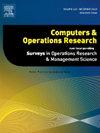A benders-branch-and-cut methodology for global cargo vessel traffic prediction given declining arctic sea ice and changing risks
IF 4.3
2区 工程技术
Q2 COMPUTER SCIENCE, INTERDISCIPLINARY APPLICATIONS
引用次数: 0
Abstract
Global warming has led to declining sea-ice in the Arctic Ocean, making it easier for ice-class vessels to navigate Arctic waters for greater portions of the year. As sailing conditions in these waters improve over coming decades, these passageways are expected to open for larger portions of the year and to become increasingly viable options for unsupported transit and even open-water vessels. This paper proposes a Benders-branch-and-cut methodology for estimating changes in global maritime cargo flow patterns under future climate scenarios with declining Arctic sea ice. The model accounts for changing incident risk along Arctic passageways and corresponding ice-class vessel and icebreaker escort requirements, lower speeds, increased insurance premiums, higher accident probabilities, and constraints on path-based maximum risk exposure. The resulting mixed-integer program involves path-based, continuous decision variables. The solution technique is applied on a model of the global maritime container network including 80 ports, 76 routes, 426 links and 4,303 legs associated with the world’s largest carrier alliance. Embedded acceleration techniques and a label-correcting algorithm that employs specialized fathoming rules for a non-additive, constrained path subproblem enable solution at this global scale. The outcome is an estimate of seasonal future global maritime trade flows along key global routes and through ports predicted under six climate-related scenarios. Results illustrate that the developed model can provide support to companies, nations and regions as they prepare for a changing global landscape and climate.
在北极海冰减少和风险变化的情况下,全球货船交通预测的折枝折枝方法
全球变暖导致北冰洋的海冰减少,这使得冰级船只在一年中的大部分时间里更容易在北极水域航行。随着未来几十年这些水域的航行条件的改善,这些通道预计将在一年中的大部分时间开放,并成为无支撑运输甚至开放水域船只的越来越可行的选择。本文提出了一种Benders-branch-and-cut方法,用于估计在北极海冰减少的未来气候情景下全球海上货物流动模式的变化。该模型考虑了北极航道上不断变化的事故风险,以及相应的冰级船舶和破冰船护航要求、更低的航速、更高的保险费、更高的事故概率,以及基于路径的最大风险暴露约束。由此产生的混合整数程序涉及基于路径的连续决策变量。该解决方案技术应用于全球海运集装箱网络模型,该网络包括与世界上最大的承运人联盟相关的80个港口、76条航线、426个链接和4303个分支。嵌入式加速技术和标签校正算法,采用非加性约束路径子问题的专门深测规则,实现了这种全球范围的解决方案。结果是对六种气候相关情景下预测的全球主要航线和港口的未来季节性全球海上贸易流量的估计。结果表明,所开发的模型可以为公司、国家和地区为不断变化的全球景观和气候做好准备提供支持。
本文章由计算机程序翻译,如有差异,请以英文原文为准。
求助全文
约1分钟内获得全文
求助全文
来源期刊

Computers & Operations Research
工程技术-工程:工业
CiteScore
8.60
自引率
8.70%
发文量
292
审稿时长
8.5 months
期刊介绍:
Operations research and computers meet in a large number of scientific fields, many of which are of vital current concern to our troubled society. These include, among others, ecology, transportation, safety, reliability, urban planning, economics, inventory control, investment strategy and logistics (including reverse logistics). Computers & Operations Research provides an international forum for the application of computers and operations research techniques to problems in these and related fields.
 求助内容:
求助内容: 应助结果提醒方式:
应助结果提醒方式:


